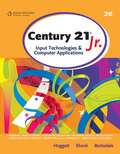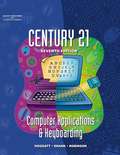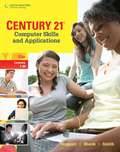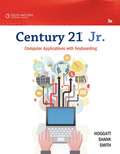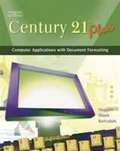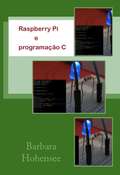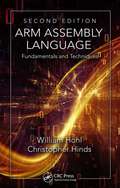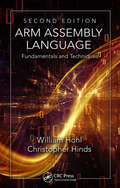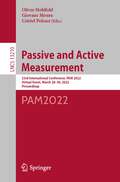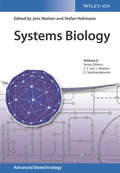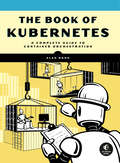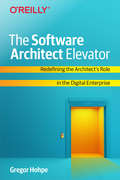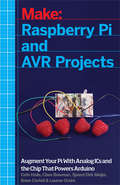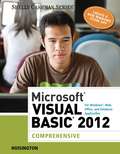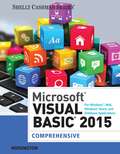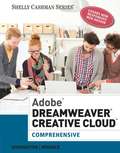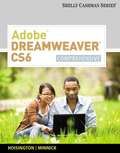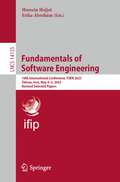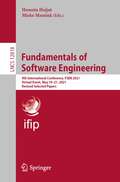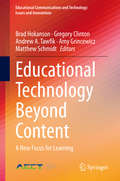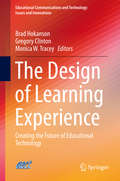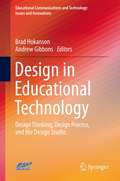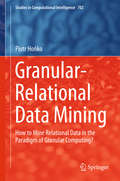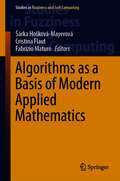- Table View
- List View
Century 21® Jr., Input Technologies & Computer Applications
by Jack P. Hoggatt Jon A. Shank Karl BarksdaleLooking for a solution to get your students started in the computer world? This introductory text, CENTURY 21, JR. INPUT TECHNOLOGIES AND COMPUTER APPLICATIONS, 2e is the perfect companion for navigation of computer basics, file management, the Internet, keyboarding, handwriting recognition, speech recognition, tablet PCs, word processing, desktop publishing, spreadsheets, presentations, databases, HTML programming, and Web pages. CENTURY 21, JR. provides step-by-step guidance, with engaging activities labeled as Learn, Practice, and Apply. Units are divided into easy-to-manage chapters and projects will help students learn the features of Microsoft Office 2007.
Century 21 Computer Applications and Keyboarding (7th Edition)
by Jack P. Hoggatt Jon A. Shank Jerry W. RobinsonThis 7th edition is a revision of Century 21 Keyboarding & Information Processing which reflects the changing keyboarding course. The complete course contains 150 keyboarding and word processing lessons, 54 computer apps lessons, and 15 new key learning lessons (in the Resources section).
Century 21® Computer Skills and Applications, Lessons 1–90
by Jack P. Hoggatt Jon A. Shank James R. SmithProvide your students with the best in keyboarding education from the proven keyboarding leader--now stronger than ever! This latest edition of CENTURY 21 COMPUTER SKILLS AND APPLICATIONS helps students prepare for a lifetime of keyboarding and computer success with innovative solutions updated to reflect today's business challenges. Students tap into the latest keyboarding technology, learn to master computer applications using Microsoft Office 2010/2013, and increase communication skills with relevant activities throughout this best-selling text. Trust the leader who has taught more than 85 million people to type--bringing 100 years of publishing experience and a century of innovations together in a complete line of keyboarding solutions.
Century 21® Jr.: Computer Applications with Keyboarding
by Jack P. Hoggatt Jon A. Shank James R. SmithJust getting started in the computer world? This introductory text, CENTURY 21(tm), JR. COMPUTER APPLICATIONS WITH KEYBOARDING, 3E is the perfect companion for navigation of computer basics, file management, the Internet, keyboarding, word processing, desktop publishing, spreadsheets, presentations, and databases. CENTURY 21, JR. provides step-by-step guidance, with engaging activities. Units are divided into easy-to-manage chapters and projects will help students learn the features of Microsoft Office 2013 and 365.
Century 21® Jr.: Computer Applications With Keyboarding (Century 21 Keyboarding Ser.)
by Jack P. Hoggatt Jon A. Shank James R. Smith Jr.NIMAC-sourced textbook
Century 21 Plus: Computer Applications with Document Formatting
by Jack Hoggatt Jon Shank Karl BarksdaleNIMAC-sourced textbook
Raspberry Pi e programação C
by Barbara Hohensee Jonathan R. Santos e Aleff E. OliveiraAprenda o básico da programação em C e contrua projetos embarcados usando Raspberry Pi e a linguagem C.
ARM Assembly Language: Fundamentals and Techniques
by William Hohl Christopher HindsDelivering a solid introduction to assembly language and embedded systems, ARM Assembly Language: Fundamentals and Techniques, Second Edition continues to support the popular ARM7TDMI, but also addresses the latest architectures from ARM, including Cortex™-A, Cortex-R, and Cortex-M processors―all of which have slightly different instruction sets, programmer’s models, and exception handling.
ARM Assembly Language: Fundamentals and Techniques, Second Edition
by William Hohl Christopher HindsDelivering a solid introduction to assembly language and embedded systems, ARM Assembly Language: Fundamentals and Techniques, Second Edition continues to support the popular ARM7TDMI, but also addresses the latest architectures from ARM, including Cortex�-A, Cortex-R, and Cortex-M processors-all of which have slightly different instruction sets, p
Passive and Active Measurement: 23rd International Conference, PAM 2022, Virtual Event, March 28–30, 2022, Proceedings (Lecture Notes in Computer Science #13210)
by Oliver Hohlfeld Giovane Moura Cristel PelsserThis book constitutes the proceedings of the 23rd International Conference on Passive and Active Measurement, PAM 2022, held in March 2022. Due to COVID-19 pandemic, the conference was held virtually. The 15 full papers and 15 short papers presented in this volume were carefully reviewed and selected from 62 submissions. The papers present emerging and early-stage research in network measurements – work that seeks to better understand complex, real-world networked systems and offer critical empirical foundations and support to network research.
Systems Biology
by Stefan Hohmann Sang Yup Lee Jens Nielsen J. Nielsen Gregory StephanopoulosComprehensive coverage of the many different aspects of systems biology, resulting in an excellent overview of the experimental and computational approaches currently in use to study biological systems. Each chapter represents a valuable introduction to one specific branch of systems biology, while also including the current state of the art and pointers to future directions. Following different methods for the integrative analysis of omics data, the book goes on to describe techniques that allow for the direct quantification of carbon fluxes in large metabolic networks, including the use of 13C labelled substrates and genome-scale metabolic models. The latter is explained on the basis of the model organism Escherichia coli as well as the human metabolism. Subsequently, the authors deal with the application of such techniques to human health and cell factory engineering, with a focus on recent progress in building genome-scale models and regulatory networks. They highlight the importance of such information for specific biological processes, including the ageing of cells, the immune system and organogenesis. The book concludes with a summary of recent advances in genome editing, which have allowed for precise genetic modifications, even with the dynamic control of gene expression. This is part of the Advances Biotechnology series, covering all pertinent aspects of the field with each volume prepared by eminent scientists who are experts on the topic in question.
The Book of Kubernetes: A Comprehensive Guide to Container Orchestration
by Alan HohnThis hands-on guidebook to the inner workings of containers peels back the layers to provide a deep understanding of what a container is, how containerization changes the way programs run, and how Kubernetes provides computing, networking, and storage.Containers ensure that software runs reliably no matter where it&’s deployed, and Kubernetes lets you manage all of your containers from a single control plane. In this comprehensive tour of the open-source platform, each chapter includes a set of example scripts with just enough automation to start your container exploration with ease. Beginning with an overview of modern architecture and the benefits of orchestration, you'll quickly learn how to create containers; how to deploy, administer and debug Kubernetes clusters all the way down to the OS; and how container networking works at the packet level across multiple nodes in a cluster.
The Software Architect Elevator: Redefining the Architect's Role in the Digital Enterprise
by Gregor HohpeAs the digital economy changes the rules of the game for enterprises, the role of software and IT architects is also transforming. Rather than focus on technical decisions alone, architects and senior technologists need to combine organizational and technical knowledge to effect change in their company’s structure and processes. To accomplish that, they need to connect the IT engine room to the penthouse, where the business strategy is defined.In this guide, author Gregor Hohpe shares real-world advice and hard-learned lessons from actual IT transformations. His anecdotes help architects, senior developers, and other IT professionals prepare for a more complex but rewarding role in the enterprise.This book is ideal for:Software architects and senior developers looking to shape the company’s technology direction or assist in an organizational transformationEnterprise architects and senior technologists searching for practical advice on how to navigate technical and organizational topicsCTOs and senior technical architects who are devising an IT strategy that impacts the way the organization worksIT managers who want to learn what’s worked and what hasn’t in large-scale transformation
Make: Raspberry Pi and AVR Projects
by Cefn Hoile Brian Corteil Clare Bowman Troy Mott Lauren Orsini Sjoerd Dirk MeijerAs an incredibly cheap, credit-card sized computer, the Raspberry Pi is breaking down barriers by encouraging people of all ages to experiment with code and build new systems and objects; and this book provides readers with inspiring and insightful examples to explore and build upon. Written for intermediate to seasoned Raspberry Pi users, this book explores four projects from around the world, explained by their makers. These projects cover five major categories in the digital maker space: music, light, games, home automation, and the Internet of Things.
Microsoft® Visual Basic 2012 for Windows, Web, Office, and Database Applications: Comprehensive
by Corinne HoisingtonMICROSOFT VISUAL BASIC 2012: COMPREHENSIVE teaches the essentials of computer programming using the latest Visual Basic programming language, Visual Basic 2012.
Microsoft® Visual Basic® 2015 for Windows®, Web, Windows® Store, and Database Applications: Comprehensive
by Corinne HoisingtonNIMAC-sourced textbook
Adobe® Dreamweaver® Creative Cloud™, Comprehensive (Stay Current With Adobe Creative Cloud Ser.)
by Corinne L. Hoisington Jessica L. MinnickNIMAC-sourced textbook
Adobe® Dreamweaver® CS6, Comprehensive
by Corinne L. Hoisington Jessica L. MinnickADOBE DREAMWEAVER CS6: COMPREHENSIVE, 1E follows the Shelly Cashman Series proven step-by-step, screen-by-screen approach to teaching the Adobe Dreamweaver CS6 software.
Fundamentals of Software Engineering: 10th International Conference, FSEN 2023, Tehran, Iran, May 4-5, 2023, Revised Selected Papers (Lecture Notes in Computer Science #14155)
by Hossein Hojjat Erika ÁbrahámThis book constitutes the thoroughly refereed post-conference proceedings of the 10th International Conference on Fundamentals of Software Engineering, FSEN 2023, held Tehran, Iran in May 4-5, 2023.The 9 full papers and 2 short papers presented in this volume were carefully reviewed and selected from 19 submissions. The topics of interest in FSEN span over all aspects of formal methods, especially those related to advancing the application of formal methods in the software industry and promoting their integration with practical engineering techniques. The papers are organized in topical sections on coordination, logic, networks, parallel computation, and testing.
Fundamentals of Software Engineering: 9th International Conference, FSEN 2021, Virtual Event, May 19–21, 2021, Revised Selected Papers (Lecture Notes in Computer Science #12818)
by Hossein Hojjat Mieke MassinkThis book constitutes the thoroughly refereed post-conference proceedings of the 9th International Conference on Fundamentals of Software Engineering, FSEN 2021, held virtually and hosted by IPM in May 2021.The 12 full papers and 4 short papers presented in this volume were carefully reviewed and selected from 38 submissions. The topics of interest in FSEN span over all aspects of formal methods, especially those related to advancing the application of formal methods in the software industry and promoting their integration with practical engineering techniques. The papers are organized in topical sections on coordination, logic, networks, parallel computation, and testing.
Educational Technology Beyond Content: A New Focus for Learning (Educational Communications and Technology: Issues and Innovations)
by Brad Hokanson Gregory Clinton Andrew A. Tawfik Amy Grincewicz Matthew SchmidtThis book is the outcome of a research symposium sponsored by the Association for Educational Communications and Technology [AECT]. Consisting of twenty-four chapters, including an introduction and conclusion, it argues that informational content should not be the main element of education, and that to provide more for learners, it is necessary to go beyond content and address other skills and capabilities. It also discusses the false premise that learning is complete when the information is known, not when learners seek more: their own directions, answers, and ideas. The authors assert that the ability to synthesize, solve problems and generate ideas is not based on specific content, although education often focuses solely on teaching content. Further, they state that content can be separated from the learning process and that instructional design and educational technology must be about the skills, habits, and beliefs to be learned.
The Design of Learning Experience
by Brad Hokanson Gregory Clinton Monica W. TraceyThis book delves into two divergent, yet parallel themes; first is an examination of how educators can design the experiences of learning, with a focus on the learner and the end results of education; and second, how educators learn to design educational products, processes and experiences. The book seeks to understand how to design how learning occurs, both in the instructional design studio and as learning occurs throughout the world. This will change the area's semantics; at a deeper level, it will change its orientation from instructors and information to learners; and it will change how educators take advantage of new and old technologies. This book is the result of a research symposium sponsored by the Association for Educational Communications and Technology [AECT].
Design in Educational Technology: Design Thinking, Design Process, and the Design Studio
by Brad Hokanson Andrew GibbonsThis book is the result of a research symposium sponsored by the Association for Educational Communications and Technology [AECT]. The fifteen chapters were developed by leaders in the field and represent the most updated and cutting edge methodology in the areas of instructional design and instructional technology. The broad concepts of design, design thinking, the design process, and the design studio, are identified and they form the framework of the book. This book advocates the conscious adoption of a mindset of design thinking, such as that evident in a range of divergent professions including business, government, and medicine. At its core is a focus on "planning, inventing, making, and doing." (Cross, 1982), all of which are of value to the field of educational technology. Additionally, the book endeavors to develop a deep understanding of the design process in the reader. It is a critical skill, often drawing from other traditional design fields. An examination of the design process as practiced, of new models for design, and of ways to connect theory to the development of educational products are all fully explored with the goal of providing guidance for emerging instructional designers and deepening the practice of more advanced practitioners. Finally, as a large number of leading schools of instructional design have adopted the studio form of education for their professional programs, we include this emerging topic in the book as a practical and focused guide for readers at all levels.
Granular-Relational Data Mining
by Piotr HońkoThis book provides two general granular computing approaches to mining relational data, the first of which uses abstract descriptions of relational objects to build their granular representation, while the second extends existing granular data mining solutions to a relational case. Both approaches make it possible to perform and improve popular data mining tasks such as classification, clustering, and association discovery. How can different relational data mining tasks best be unified? How can the construction process of relational patterns be simplified? How can richer knowledge from relational data be discovered? All these questions can be answered in the same way: by mining relational data in the paradigm of granular computing! This book will allow readers with previous experience in the field of relational data mining to discover the many benefits of its granular perspective. In turn, those readers familiar with the paradigm of granular computing will find valuable insights on its application to mining relational data. Lastly, the book offers all readers interested in computational intelligence in the broader sense the opportunity to deepen their understanding of the newly emerging field granular-relational data mining.
Algorithms as a Basis of Modern Applied Mathematics (Studies in Fuzziness and Soft Computing #404)
by Šárka Hošková-Mayerová Cristina Flaut Fabrizio MaturoThis book offers a self-contained guide to advanced algorithms and their applications in various fields of science. Gathering contributions by authoritative researchers in the field of mathematics, statistics and computer science, it aims at offering a comprehensive and up-to-date view of algorithms, including the theory behind them, as well as practical considerations, current limitations and solutions. It covers applications in energy management, decision making, computer networks, materials science, mechanics and process optimization. It offers an integrated and timely guide to important algorithms, and represents a valuable reference resource for graduate students and researchers in various fields of applied mathematics, statistics and engineering.
